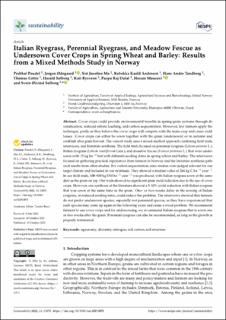| dc.description.abstract | Cover crops could provide environmental benefits in spring-grain systems through diversification, reduced nitrate leaching, and carbon sequestration. However, few farmers apply the technique, partly as they believe the cover crops will compete with the main crop and cause yield losses. Cover crops can either be sown together with the grain (undersown) or in autumn and establish after grain harvest. The current study uses a mixed-method approach combining field trials, interviews, and literature synthesis. The field trials focused on perennial ryegrass (Lolium perenne L.), Italian ryegrass (Lolium multiflorum Lam.), and meadow fescue (Festuca pratensis L.) that were undersown with 15 kg ha−1 but with different seeding dates in spring wheat and barley. The interviews focused on gathering practical experiences from farmers in Norway and the literature synthesis gathered results from other studies. For carbon sequestration, nine studies were judged relevant for our target climate and included in our synthesis. They showed a median value at 264 kg C ha−1 year−1 . In our field trials, 300–900 kg DM ha−1 year−1 was produced, with Italian ryegrass sown at the same date as the grain on top. Our trials showed no significant grain yield reduction due to the use of cover crops. However, our synthesis of the literature showed a 5–10% yield reduction with Italian ryegrass that was sown at the same time as the grain. One- or two-weeks delay in the sowing of Italian ryegrass, or reduced seeding rates, could reduce the problem. The interviews showed that farmers do not prefer undersown species, especially not perennial species, as they have experienced that such species may come up again in the following years and cause a weed problem. We recommend farmers to use cover crops and for undersowing, we recommend Italian ryegrass that is sown one or two weeks after the grain. Perennial ryegrass can also be recommended, as long as the growth is properly terminated. | en_US |

